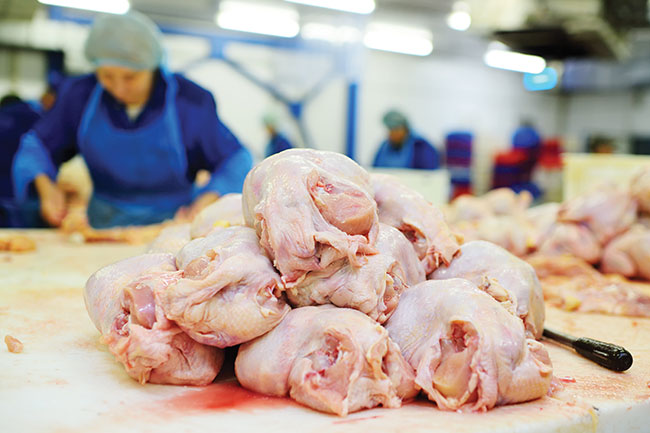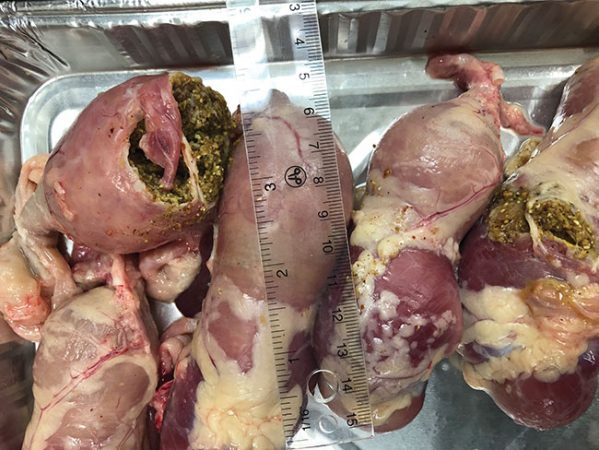
Emerging Poultry Disease: Searching for answers
By Lilian Schaer
Features BroilersBroiler industry experts puzzled by mysterious syndrome appearing countrywide.
 Experts were puzzled as to why broiler chickens began showing up at processing plants with dilated proventriculi or full stomachs. Photo: © Evgeniy Kalinovskiy / adobe stock
Experts were puzzled as to why broiler chickens began showing up at processing plants with dilated proventriculi or full stomachs. Photo: © Evgeniy Kalinovskiy / adobe stock There’s an emerging disease in Canada’s poultry sector. It’s one that has been puzzling experts since it first started appearing in Canadian chicken processing plants over the last 18 months or so.
Broiler chickens have been showing up at processing plants with dilated proventriculi or full stomachs but without a known cause, leading to the condition being called proventricular dilation syndrome in Ontario.
“We started getting calls from processors in fall 2018 facing challenges with contamination at processing,” explains Al Dam, poultry specialist with the Ontario Ministry of Agriculture, Food and Rural Affairs (OMAFRA). “It looked like the birds didn’t have enough feed withdrawal time before loading, but even when feed was withdrawn properly, we were still seeing it.”
And there would be no improvement in the condition even after the birds were returned to lairage for a couple of hours before processing, he adds.
Proventricular dilation
The proventriculus is a digestive organ located after the esophagus and before the gizzard. It secretes acid and enzymes to help break down feed as it moves through the gastrointestinal tract. In healthy birds, the proventriculus is smaller than the gizzard and the connection between the two organs, called gastric isthmus, is constricted.
With dilation, the proventriculus and the gizzard become a single tube and feed stops passing through the gastrointestinal tract.
Outwardly, birds can look as though they have pendulous crop. Catchers have been noticing that afflicted birds were heavy, as if full of feed. Farmers have reported birds reaching processing weights two to four days ahead of schedule.
When the condition presents at slaughter, processors must slow down the line to remove the affected birds. That’s because they present food safety and carcass contamination risks.
“When processors pay on live weight, they’re actually also paying for feed in the gut while expecting that weight to be there in breast meat,” Dam says.
By fall 2019, calls started coming in about higher numbers of sudden death on-farm of birds close to market weight. When autopsies were performed, many of those birds were found to have dilated, feed-filled proventriculi, crop that looks like pendulous crop and empty intestines.
Experts puzzled
According to OMAFRA veterinarian Alison Moore, who has been working on the issue on an interim basis in the absence of a provincial poultry veterinarian, veterinarians at first speculated the culprit could be transmissible viral proventriculitis (TVP) or chicken proventriculitis necrosis virus (CPNV).
“When pathologists looked at the issue at a cellular level, it didn’t look like textbook TVP from the lesions or the type of inflammation – and they saw inflammation in some birds but not all,” Moore says. “Tissue had to be sent to California for testing for CPNV because we don’t have the capacity, and of 18 samples, three came back positive – so how does that account for the other 15?”
No other possible causes have been identified either. The syndrome affects both roasters and standard broilers, is not breed or sex specific, does not distinguish between conventional and raised without antibiotics production systems and has been seen at multiple processing plants.
There is also no known feed ingredient association between diets that feature a corn-soy versus wheat ration – and although mycotoxin levels were high in 2018, they weren’t in 2019.
Trying to figure out the cause has been frustrating for Dam and others working on the issue. Anecdotal evidence suggests farmers are now starting to notice the syndrome in younger birds when doing health checks with their veterinarians.
According to Dam, a complicating factor is that about 20 per cent of Canadian broilers come from all over the U.S. as fertile eggs or day-old chicks and not much is known about the health conditions of breeder flocks stateside.

With dilation, the proventriculus and the gizzard become a single tube and feed stops passing through the gastrointestinal tract. Photo:University of Saskatchewan Poultry Extension
Research efforts
In Saskatchewan, funding has been allocated from the Western College of Veterinary Medicine Disease Investigation Unit to investigate the issue. Researchers have collected carcass data from nine affected flocks, with collection from a tenth flock still pending. The University of Saskatchewan has temporarily put non-essential research on hold as a result of the coronavirus pandemic.
According to Tennille Knezacek of the Poultry Extension Service at U of S’s Department of Animal and Poultry Science, 55 to 81 per cent of 100 birds examined from each affected flock to date have some degree of enlarged proventriculi.
“In extreme, individual bird cases, the digesta weight in both the proventriculus and gizzard has reached 140 grams, representing a huge economic loss to the processor,” she says.
The researchers have not completed correlation statistics, but evidence to date suggests the incidences do not appear to be seasonal or farm, barn or breeder flock-specific.
A separate research project, also temporarily on hold, involves tissue sample collections from broilers on-farm between 15 to 20 days of age. Knezacek and her team will also be on the lookout for enlarged proventriculi in those young birds once the project is back up and running.
Dam says Ontario’s Industry Broiler Health working group, which includes hatcheries, processors, farmers, veterinarians, academia, OMAFRA and the Animal Health Lab at the University of Guelph, is working on the issue. They’re ready and willing to work with anyone in other provinces, he insists.
Advice for producers
Since the cause of enlarged proventriculi is unknown and likely a multi-factorial condition, it is difficult to make specific recommendations to prevent the condition, according to Knezacek. However, there are some general recommendations she says producers can follow:
- Keep good production, feeding and vaccination records by following On-Farm Food Safety and the Chicken Farmers of Canada Animal Care Program.
- Review vaccination schedules with a poultry veterinarian.
- Communicate with processors to determine if birds are affected.
- Thoroughly clean and disinfect the barn between flocks.
- Sanitize water lines and ventilate barns properly.
“If you suspect your flock is affected, talk to your veterinarian and to your processor – the processor can prepare if it is a problem flock,” Dam adds.
Print this page